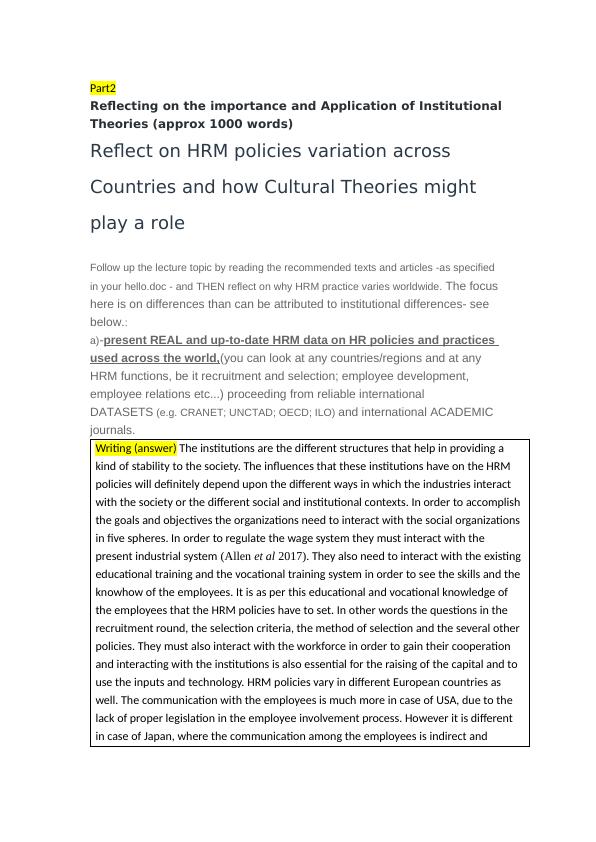(PDF) Institutional Theory Approaches
5 Pages1488 Words59 Views
Loyola Marymount University
Added on 2020-05-04
(PDF) Institutional Theory Approaches
Loyola Marymount University
Added on 2020-05-04
ShareRelated Documents
Part2Reflecting on the importance and Application of InstitutionalTheories (approx 1000 words)Reflect on HRM policies variation across Countries and how Cultural Theories might play a roleFollow up the lecture topic by reading the recommended texts and articles -as specified in your hello.doc - and THEN reflect on why HRM practice varies worldwide.The focus here is on differences than can be attributed to institutional differences- see below.:a)-present REAL and up-to-date HRM data on HR policies and practices used across the world,(you can look at any countries/regions and at any HRM functions, be it recruitment and selection; employee development, employee relations etc...) proceeding from reliable international DATASETS(e.g. CRANET; UNCTAD; OECD; ILO)and international ACADEMIC journals.Writing (answer) The institutions are the different structures that help in providing a kind of stability to the society. The influences that these institutions have on the HRM policies will definitely depend upon the different ways in which the industries interact with the society or the different social and institutional contexts. In order to accomplish the goals and objectives the organizations need to interact with the social organizations in five spheres. In order to regulate the wage system they must interact with the present industrial system (Allen et al 2017). They also need to interact with the existing educational training and the vocational training system in order to see the skills and the knowhow of the employees. It is as per this educational and vocational knowledge of the employees that the HRM policies have to set. In other words the questions in the recruitment round, the selection criteria, the method of selection and the several other policies. They must also interact with the workforce in order to gain their cooperation and interacting with the institutions is also essential for the raising of the capital and to use the inputs and technology. HRM policies vary in different European countries as well. The communication with the employees is much more in case of USA, due to the lack of proper legislation in the employee involvement process. However it is different in case of Japan, where the communication among the employees is indirect and

unclear.REFLECT And DISCUSS: What are the implications of institutional theories for IHRM practice?Can you explain/discuss the HRM differences presented earlier by using institutional theories? (You can also refer to differences mentioned in log 1). Try to back up your discussion with academic literature (e.g. Halls and Soskice; Whitley; Paik et al's paper, special focus on Table 1).Please note: A brief introduction to your chosen institutional theory would helpbut no 'description' please; awareness and knowledge will be demonstrated by competent application and integration with the HRM analysis.Writing(answer)There are many institutional aspects that influence the formulation of the HRM policies as well. Power distance is one of the important institutional aspects. Many countries like that of India, Nigeria, China, and Bangladesh follow the high power distance orthe autocratic leadership. Whereas on the other hand, the developed countries like that of New Zealand, Sweden, United Kingdom has a low power distance (Budhwar et al 2016). On the low power system, the employees are usually having more freedom in interacting with the managers and they have a greater scope of knowledge sharing. This is however present mostly within the low power system countries. Another influence in this context is that of formal institutional aspect, which usually refers to the kind of codified rules and standards that characterize the in interaction among the social members. There are also three differentkinds of systems through which the intuitionalism is formulated (Alfes et al 2013). The HRM policies of different countries are formed as per the constitutions and the rules and regulations formulated in the same. This is because of the fact that the performance of the employees will naturally depend upon the rules governing the country. These factors includethe industrial or the employment laws, formal public policies. Another important aspect is that of the enforcement system. The country’s judiciary system, property rights, the taxation policies and all the other enforcement mechanisms play a major rule in enabling the companies to set the HRM policies. A good example is the difference between the HRM policy of Germany and UK. As far as the HRM policies of the German company are concerned, they invest a lot for the vocational training of the employees. On the other hand

End of preview
Want to access all the pages? Upload your documents or become a member.
Related Documents
The Importance of Cultural Theories for International HRMlg...
|4
|1393
|80
International Strategies for HRM: Assessmentlg...
|5
|1905
|511
Organisational Ethics and Corporate Social Responsibility | Essaylg...
|5
|1699
|444
Review of Company Recruitment and Selection Strategylg...
|12
|2732
|157
Quality Assurance - A Registered Manager’s Responsibilities in Dental Practice Managementlg...
|8
|3167
|329
Human Resource Management - The Chicken Master | Case Studylg...
|30
|7238
|389
